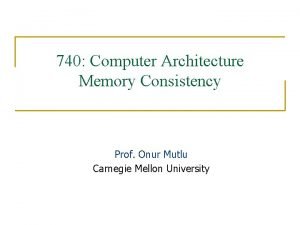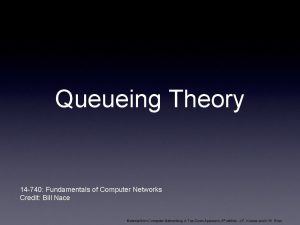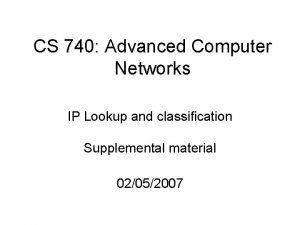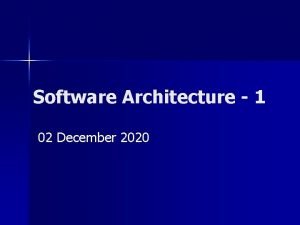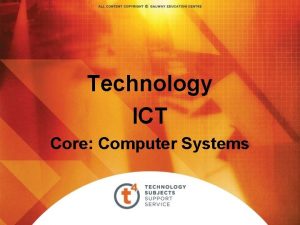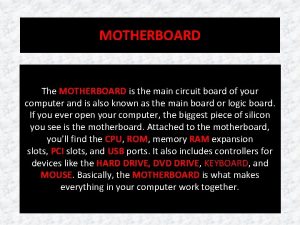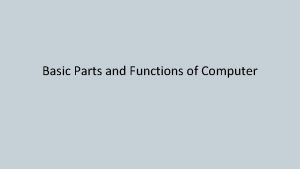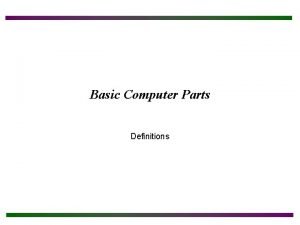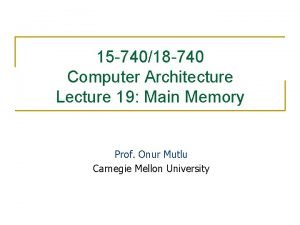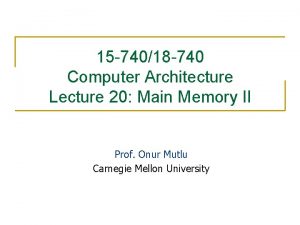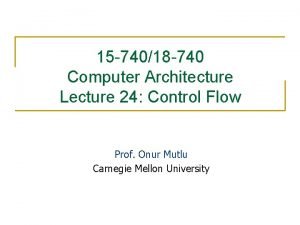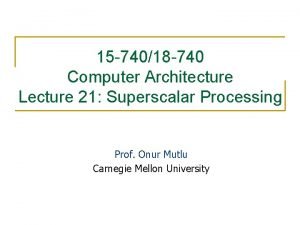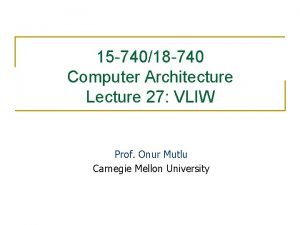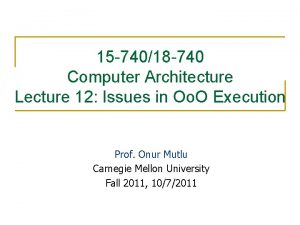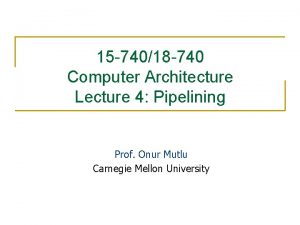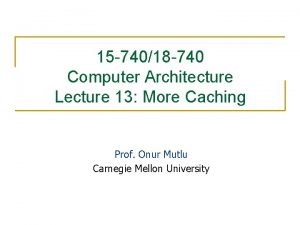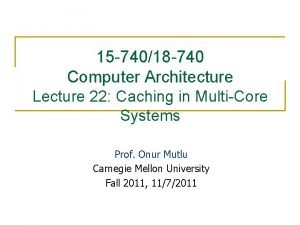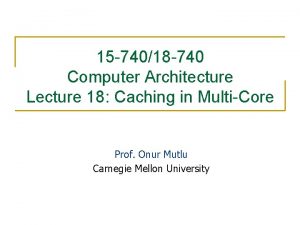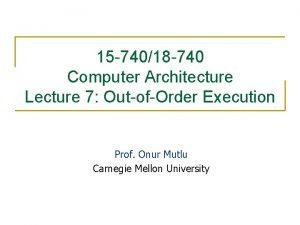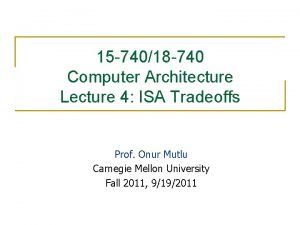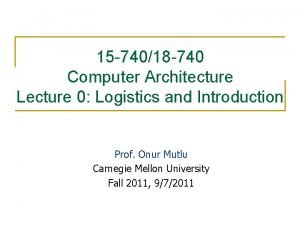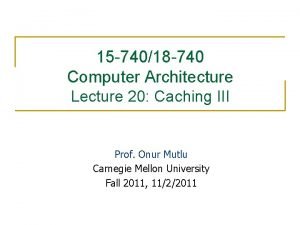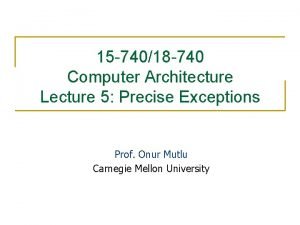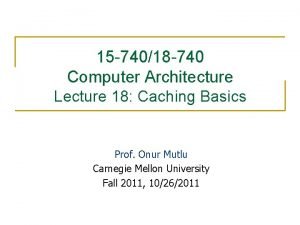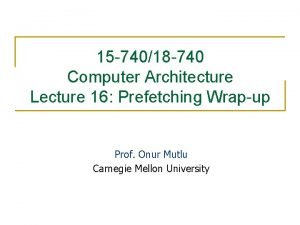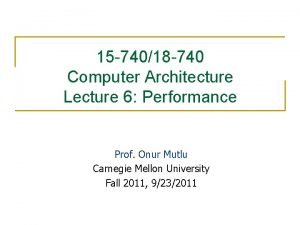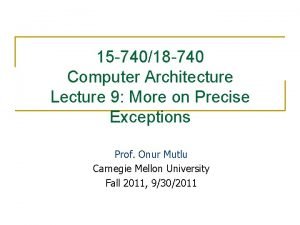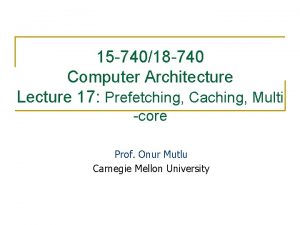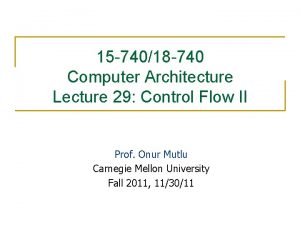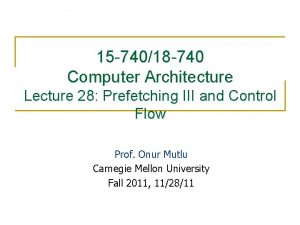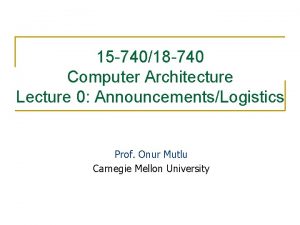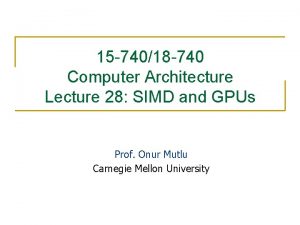15 74018 740 Computer Architecture Lecture 25 Main


















































- Slides: 50

15 -740/18 -740 Computer Architecture Lecture 25: Main Memory Prof. Onur Mutlu Yoongu Kim Carnegie Mellon University

Today n n n SRAM vs. DRAM Interleaving/Banking DRAM Microarchitecture q q q n n n Memory controller Memory buses Banks, ranks, channels, DIMMs Address mapping: software vs. hardware DRAM refresh Memory scheduling policies Memory power/energy management Multi-core issues q q Fairness, interference Large DRAM capacity 2

Readings n Recommended: q q q Mutlu and Moscibroda, “Parallelism-Aware Batch Scheduling: Enabling High-Performance and Fair Memory Controllers, ” IEEE Micro Top Picks 2009. Mutlu and Moscibroda, “Stall-Time Fair Memory Access Scheduling for Chip Multiprocessors, ” MICRO 2007. Zhang et al. , “A Permutation-based Page Interleaving Scheme to Reduce Row-buffer Conflicts and Exploit Data Locality, ” MICRO 2000. Lee et al. , “Prefetch-Aware DRAM Controllers, ” MICRO 2008. Rixner et al. , “Memory Access Scheduling, ” ISCA 2000. 3

Main Memory in the System DRAM BANKS L 2 CACHE 3 L 2 CACHE 2 SHARED L 3 CACHE DRAM MEMORY CONTROLLER DRAM INTERFACE L 2 CACHE 1 L 2 CACHE 0 CORE 3 CORE 2 CORE 1 CORE 0 4

Memory Bank Organization n Read access sequence: 1. Decode row address & drive word-lines 2. Selected bits drive bit -lines • Entire row read 3. Amplify row data 4. Decode column address & select subset of row • Send to output 5. Precharge bit-lines • For next access 5

bitline _bitline SRAM (Static Random Access Read Sequence Memory) row select bit-cell array n+m 2 n n m 1. address decode 2. drive row select 3. selected bit-cells drive bitlines (entire row is read together) 4. diff. sensing and col. select (data is ready) 5. precharge all bitlines (for next read or write) 2 n row x 2 m-col Access latency dominated by steps 2 and 3 (n m to minimize overall latency) Cycling time dominated by steps 2, 3 and 5 - 2 m diff pairs sense amp and mux 1 step 2 proportional to 2 m step 3 and 5 proportional to 2 n 6

_bitline DRAM (Dynamic Random Access row enable Memory) Bits stored as charges on node RAS bit-cell array 2 n n 2 n row x 2 m-col (n m to minimize overall latency) m CAS 2 m sense amp and mux 1 capacitance (non-restorative) - bit cell loses charge when read - bit cell loses charge over time Read Sequence 1~3 same as SRAM 4. a “flip-flopping” sense amplifies and regenerates the bitline, data bit is mux’ed out 5. precharge all bitlines Refresh: A DRAM controller must periodically read all rows within the allowed refresh time (10 s of ms) such that charge is restored in cells A DRAM die comprises of multiple such arrays 7

SRAM vs. DRAM n SRAM is preferable for register files and L 1/L 2 caches q q q n Fast access No refreshes Simpler manufacturing (compatible with logic process) Lower density (6 transistors per cell) Higher cost DRAM is preferable for stand-alone memory chips q q q Much higher capacity Higher density Lower cost 8

Memory subsystem organization • Memory subsystem organization – Channel – DIMM – Rank – Chip – Bank – Row/Column

Memory subsystem “Channel” DIMM (Dual in-line memory module) Processor Memory channel

Breaking down a DIMM (Dual in-line memory module) Side view Front of DIMM Back of DIMM

Breaking down a DIMM (Dual in-line memory module) Side view Front of DIMM Rank 0: collection of 8 chips Back of DIMM Rank 1

Rank 0 (Front) Rank 1 (Back) <0: 63> Addr/Cmd CS <0: 1> Memory channel <0: 63> Data <0: 63>

DIMM & Rank (from JEDEC)

Chip 7 . . . <56: 63> Chip 1 <8: 15> <0: 63> <0: 7> Rank 0 Chip 0 Breaking down a Rank Data <0: 63>

Bank 0 <0: 7> . . . <0: 7> Chip 0 8 b an ks Breaking down a Chip

Breaking down a Bank 2 k. B 1 B (column) row 16 k-1 . . . Bank 0 <0: 7> row 0 Row-buffer 1 B . . . <0: 7> 1 B 1 B

Memory subsystem organization • Memory subsystem organization – Channel – DIMM – Rank – Chip – Bank – Row/Column

Example: Transferring a cache block Physical memory space 0 x. FFFF…F . . . Channel 0 DIMM 0 0 x 40 64 B cache block 0 x 00 M d to e p ap Rank 0

Example: Transferring a cache block Physical memory space Chip 0 Chip 1 0 x. FFFF…F Rank 0 Chip 7 <56: 63> <8: 15> <0: 7> . . . 0 x 40 64 B cache block 0 x 00 Data <0: 63>

Example: Transferring a cache block Physical memory space Chip 0 Chip 1 0 x. FFFF…F Rank 0 . . . <56: 63> <8: 15> <0: 7> . . . Row 0 Col 0 0 x 40 64 B cache block 0 x 00 Chip 7 Data <0: 63>

Example: Transferring a cache block Physical memory space Chip 0 Chip 1 Rank 0 0 x. FFFF…F . . . <56: 63> <8: 15> <0: 7> . . . Row 0 Col 0 0 x 40 64 B cache block 0 x 00 Chip 7 Data <0: 63> 8 B 8 B

Example: Transferring a cache block Physical memory space Chip 0 Chip 1 0 x. FFFF…F Rank 0 . . . <56: 63> <8: 15> <0: 7> . . . Row 0 Col 1 0 x 40 64 B cache block 0 x 00 8 B Chip 7 Data <0: 63>

Example: Transferring a cache block Physical memory space Chip 0 Chip 1 Rank 0 0 x. FFFF…F . . . <56: 63> <8: 15> <0: 7> . . . Row 0 Col 1 0 x 40 8 B 0 x 00 Chip 7 64 B cache block Data <0: 63> 8 B 8 B

Example: Transferring a cache block Physical memory space Chip 0 Chip 1 0 x. FFFF…F Rank 0 Chip 7 . . . <56: 63> <8: 15> <0: 7> . . . Row 0 Col 1 0 x 40 8 B 0 x 00 64 B cache block Data <0: 63> 8 B A 64 B cache block takes 8 I/O cycles to transfer. During the process, 8 columns are read sequentially.

Page Mode DRAM n n n A DRAM bank is a 2 D array of cells: rows x columns A “DRAM row” is also called a “DRAM page” “Sense amplifiers” also called “row buffer” Each address is a <row, column> pair Access to a “closed row” q q q n Activate command opens row (placed into row buffer) Read/write command reads/writes column in the row buffer Precharge command closes the row and prepares the bank for next access Access to an “open row” q No need for activate command 26

DRAM Bank Operation Rows Row address 0 1 Columns Row decoder Access Address: (Row 0, Column 0) (Row 0, Column 1) (Row 0, Column 85) (Row 1, Column 0) Row 01 Row Empty Column address 0 1 85 Row Buffer CONFLICT HIT ! Column mux Data 27

Latency Components: Basic DRAM Operation n CPU → controller transfer time n Controller latency q q n n Controller → DRAM transfer time DRAM bank latency q q q n Queuing & scheduling delay at the controller Access converted to basic commands Simple CAS is row is “open” OR RAS + CAS if array precharged OR PRE + RAS + CAS (worst case) DRAM → CPU transfer time (through controller) 28

A DRAM Chip and DIMM n Chip: Consists of multiple banks (2 -16 in Synchronous DRAM) Banks share command/address/data buses The chip itself has a narrow interface (4 -16 bits per read) n Multiple chips are put together to form a wide interface n n q q q Called a module DIMM: Dual Inline Memory Module All chips in one side of a DIMM are operated the same way (rank) n n n Respond to a single command Share address and command buses, but provide different data If we have chips with 8 -bit interface, to read 8 bytes in a single access, use 8 chips in a DIMM 29

128 M x 8 -bit DRAM Chip 30

A 64 -bit Wide DIMM 31

A 64 -bit Wide DIMM n Advantages: q q n Acts like a highcapacity DRAM chip with a wide interface Flexibility: memory controller does not need to deal with individual chips Disadvantages: q Granularity: Accesses cannot be smaller than the interface width 32

Multiple DIMMs n Advantages: q n Enables even higher capacity Disadvantages: q Interconnect complexity and energy consumption can be high 33

DRAM Channels n n 2 Independent Channels: 2 Memory Controllers (Above) 2 Dependent/Lockstep Channels: 1 Memory Controller with wide interface (Not Shown above) 34

Generalized Memory Structure 35

Multiple Banks (Interleaving) and n. Channels Multiple banks q q n Multiple independent channels serve the same purpose q q n But they are even better because they have separate data buses Increased bus bandwidth Enabling more concurrency requires reducing q q n Enable concurrent DRAM accesses Bits in address determine which bank an address resides in Bank conflicts Channel conflicts How to select/randomize bank/channel indices in address? q q Lower order bits have more entropy Randomizing hash functions (XOR of different address bits) 36

How Multiple Banks/Channels Help 37

Multiple Channels n Advantages q q n Increased bandwidth Multiple concurrent accesses (if independent channels) Disadvantages q Higher cost than a single channel n n More board wires More pins (if on-chip memory controller) 38

Address Mapping (Single Channel) n Single-channel system with 8 -byte memory bus q n 2 GB memory, 8 banks, 16 K rows & 2 K columns per bank Row interleaving q Consecutive rows of memory in consecutive banks Row (14 bits) n Bank (3 bits) Column (11 bits) Byte in bus (3 bits) Cache block interleaving n n Consecutive cache block addresses in consecutive banks 64 byte cache blocks Row (14 bits) High Column 8 bits n n Bank (3 bits) Low Col. Byte in bus (3 bits) 3 bits Accesses to consecutive cache blocks can be serviced in parallel How about random accesses? Strided accesses? 39

Bank Mapping Randomization n DRAM controller can randomize the address mapping to banks so that bank conflicts are less likely 3 bits Column (11 bits) Byte in bus (3 bits) XOR Bank index (3 bits) 40

Address Mapping (Multiple Channels) C Row (14 bits) n C Bank (3 bits) Column (11 bits) Byte in bus (3 bits) Row (14 bits) Bank (3 bits) Column (11 bits) C Byte in bus (3 bits) Where are consecutive cache blocks? Row (14 bits) High Column Bank (3 bits) Low Col. 3 bits 8 bits Row (14 bits) C High Column Bank (3 bits) Low Col. High Column C Bank (3 bits) Low Col. High Column Bank (3 bits) C High Column 8 bits Low Col. Byte in bus (3 bits) 3 bits 8 bits Row (14 bits) Byte in bus (3 bits) Bank (3 bits) Low Col. C Byte in bus (3 bits) 3 bits 41

Interaction with Virtual Physical Mapping n Operating System influences where an address maps to in DRAM Virtual Page number (52 bits) Physical Frame number (19 bits) Row (14 bits) n n Bank (3 bits) Page offset (12 bits) VA Page offset (12 bits) PA Column (11 bits) Byte in bus (3 bits) PA Operating system can control which bank a virtual page is mapped to. It can randomize Page <Bank, Channel> mappings Application cannot know/determine which bank it is accessing 42

DRAM Refresh (I) n n DRAM capacitor charge leaks over time The memory controller needs to read each row periodically to restore the charge q q n Activate + precharge each row every N ms Typical N = 64 ms Implications on performance? -- DRAM bank unavailable while refreshed -- Long pause times: If we refresh all rows in burst, every 64 ms the DRAM will be unavailable until refresh ends n n Burst refresh: All rows refreshed immediately after one another Distributed refresh: Each row refreshed at a different time, at regular intervals 43

DRAM Refresh (II) n n Distributed refresh eliminates long pause times How else we can reduce the effect of refresh on performance? q Can we reduce the number of refreshes? 44

DRAM Controller n Purpose and functions q q Ensure correct operation of DRAM (refresh) Service DRAM requests while obeying timing constraints of DRAM chips n n q Buffer and schedule requests to improve performance n q Constraints: resource conflicts (bank, bus, channel), minimum write-to-read delays Translate requests to DRAM command sequences Reordering and row-buffer management Manage power consumption and thermals in DRAM n Turn on/off DRAM chips, manage power modes 45

DRAM Controller Issues n Where to place? q In chipset + More flexibility to plug different DRAM types into the system + Less power density in the CPU chip q On CPU chip + Reduced latency for main memory access + Higher bandwidth between cores and controller q More information can be communicated (e. g. request’s importance in the processing core) 46

DRAM Controller (II) 47

A Modern DRAM Controller 48

DRAM Scheduling Policies (I) n FCFS (first come first served) q n Oldest request first FR-FCFS (first ready, first come first served) 1. Row-hit first 2. Oldest first Goal: Maximize row buffer hit rate maximize DRAM throughput q Actually, scheduling is done at the command level n n Column commands (read/write) prioritized over row commands (activate/precharge) Within each group, older commands prioritized over younger ones 49

DRAM Scheduling Policies (II) n A scheduling policy is essentially a prioritization order n Prioritization can be based on q q q Request age Row buffer hit/miss status Request type (prefetch, read, write) Requestor type (load miss or store miss) Request criticality n n Oldest miss in the core? How many instructions in core are dependent on it? 50
 Computer architecture notes
Computer architecture notes Microarchitecture vs isa
Microarchitecture vs isa Asc 740
Asc 740 Fin 18 interim tax provision
Fin 18 interim tax provision Deloitte asc 740
Deloitte asc 740 740
740 Gabriel deloitte
Gabriel deloitte 740
740 Who wrote the ffa creed? when was it adopted?
Who wrote the ffa creed? when was it adopted? 14-740
14-740 F 740
F 740 R 740
R 740 Cs 740
Cs 740 01:640:244 lecture notes - lecture 15: plat, idah, farad
01:640:244 lecture notes - lecture 15: plat, idah, farad Buses in computer architecture
Buses in computer architecture Computer architecture and organization difference
Computer architecture and organization difference What is basic computer organization
What is basic computer organization Computer security 161 cryptocurrency lecture
Computer security 161 cryptocurrency lecture Computer aided drug design lecture notes
Computer aided drug design lecture notes Expressing future time
Expressing future time Stated main idea
Stated main idea Void main int main
Void main int main Main/subroutine architecture
Main/subroutine architecture Call and return architecture style
Call and return architecture style 3 components of computer
3 components of computer Motherboard circuit board
Motherboard circuit board Example of a micro computer
Example of a micro computer Basic computer parts
Basic computer parts Basic computer part
Basic computer part Architecture business cycle activities
Architecture business cycle activities Call and return architecture
Call and return architecture Modular architecture vs integrated architecture
Modular architecture vs integrated architecture Slot modular architecture examples
Slot modular architecture examples Computer organization and architecture 10th solution
Computer organization and architecture 10th solution Intel pentium
Intel pentium Iit kharagpur virtual lab
Iit kharagpur virtual lab Introduction to computer organization and architecture
Introduction to computer organization and architecture Timing and control in computer architecture
Timing and control in computer architecture Evolution and interpretation of computer architecture
Evolution and interpretation of computer architecture Programmed i/o in computer architecture
Programmed i/o in computer architecture Fp adder
Fp adder Lmc addressing modes
Lmc addressing modes Chordal ring
Chordal ring Smt computer architecture
Smt computer architecture What is pseudo instruction
What is pseudo instruction 111011-100100
111011-100100 Instruction format in computer architecture
Instruction format in computer architecture Nano programming in computer architecture
Nano programming in computer architecture A microprogram sequencer ______________________.
A microprogram sequencer ______________________. Memory system design
Memory system design Tlb computer architecture
Tlb computer architecture







